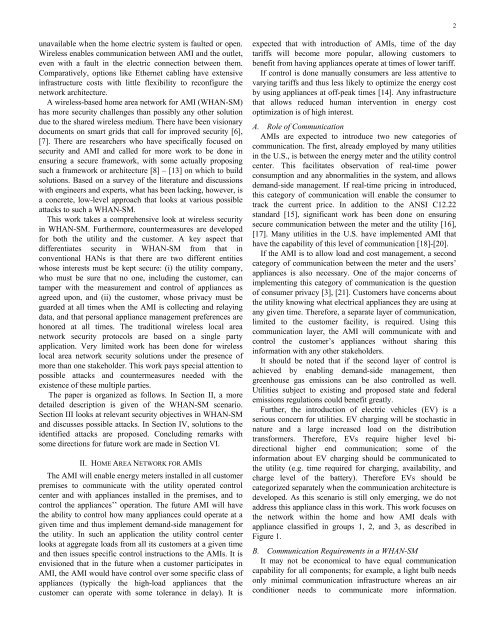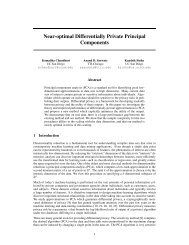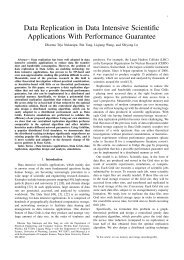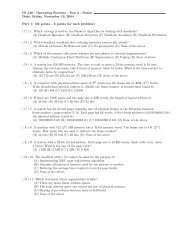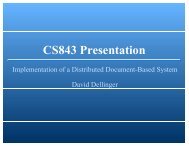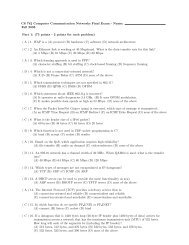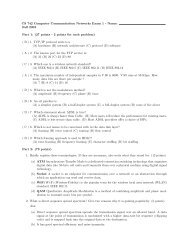Wireless AMI Application and Security for Controlled Home Area ...
Wireless AMI Application and Security for Controlled Home Area ...
Wireless AMI Application and Security for Controlled Home Area ...
You also want an ePaper? Increase the reach of your titles
YUMPU automatically turns print PDFs into web optimized ePapers that Google loves.
2unavailable when the home electric system is faulted or open.<strong>Wireless</strong> enables communication between <strong>AMI</strong> <strong>and</strong> the outlet,even with a fault in the electric connection between them.Comparatively, options like Ethernet cabling have extensiveinfrastructure costs with little flexibility to reconfigure thenetwork architecture.A wireless-based home area network <strong>for</strong> <strong>AMI</strong> (WHAN-SM)has more security challenges than possibly any other solutiondue to the shared wireless medium. There have been visionarydocuments on smart grids that call <strong>for</strong> improved security [6],[7]. There are researchers who have specifically focused onsecurity <strong>and</strong> <strong>AMI</strong> <strong>and</strong> called <strong>for</strong> more work to be done inensuring a secure framework, with some actually proposingsuch a framework or architecture [8] – [13] on which to buildsolutions. Based on a survey of the literature <strong>and</strong> discussionswith engineers <strong>and</strong> experts, what has been lacking, however, isa concrete, low-level approach that looks at various possibleattacks to such a WHAN-SM.This work takes a comprehensive look at wireless securityin WHAN-SM. Furthermore, countermeasures are developed<strong>for</strong> both the utility <strong>and</strong> the customer. A key aspect thatdifferentiates security in WHAN-SM from that inconventional HANs is that there are two different entitieswhose interests must be kept secure: (i) the utility company,who must be sure that no one, including the customer, cantamper with the measurement <strong>and</strong> control of appliances asagreed upon, <strong>and</strong> (ii) the customer, whose privacy must beguarded at all times when the <strong>AMI</strong> is collecting <strong>and</strong> relayingdata, <strong>and</strong> that personal appliance management preferences arehonored at all times. The traditional wireless local areanetwork security protocols are based on a single partyapplication. Very limited work has been done <strong>for</strong> wirelesslocal area network security solutions under the presence ofmore than one stakeholder. This work pays special attention topossible attacks <strong>and</strong> countermeasures needed with theexistence of these multiple parties.The paper is organized as follows. In Section II, a moredetailed description is given of the WHAN-SM scenario.Section III looks at relevant security objectives in WHAN-SM<strong>and</strong> discusses possible attacks. In Section IV, solutions to theidentified attacks are proposed. Concluding remarks withsome directions <strong>for</strong> future work are made in Section VI.II. HOME AREA NETWORK FOR <strong>AMI</strong>SThe <strong>AMI</strong> will enable energy meters installed in all customerpremises to communicate with the utility operated controlcenter <strong>and</strong> with appliances installed in the premises, <strong>and</strong> tocontrol the appliances’’ operation. The future <strong>AMI</strong> will havethe ability to control how many appliances could operate at agiven time <strong>and</strong> thus implement dem<strong>and</strong>-side management <strong>for</strong>the utility. In such an application the utility control centerlooks at aggregate loads from all its customers at a given time<strong>and</strong> then issues specific control instructions to the <strong>AMI</strong>s. It isenvisioned that in the future when a customer participates in<strong>AMI</strong>, the <strong>AMI</strong> would have control over some specific class ofappliances (typically the high-load appliances that thecustomer can operate with some tolerance in delay). It isexpected that with introduction of <strong>AMI</strong>s, time of the daytariffs will become more popular, allowing customers tobenefit from having appliances operate at times of lower tariff.If control is done manually consumers are less attentive tovarying tariffs <strong>and</strong> thus less likely to optimize the energy costby using appliances at off-peak times [14]. Any infrastructurethat allows reduced human intervention in energy costoptimization is of high interest.A. Role of Communication<strong>AMI</strong>s are expected to introduce two new categories ofcommunication. The first, already employed by many utilitiesin the U.S., is between the energy meter <strong>and</strong> the utility controlcenter. This facilitates observation of real-time powerconsumption <strong>and</strong> any abnormalities in the system, <strong>and</strong> allowsdem<strong>and</strong>-side management. If real-time pricing in introduced,this category of communication will enable the consumer totrack the current price. In addition to the ANSI C12.22st<strong>and</strong>ard [15], significant work has been done on ensuringsecure communication between the meter <strong>and</strong> the utility [16],[17]. Many utilities in the U.S. have implemented <strong>AMI</strong> thathave the capability of this level of communication [18]-[20].If the <strong>AMI</strong> is to allow load <strong>and</strong> cost management, a secondcategory of communication between the meter <strong>and</strong> the users’appliances is also necessary. One of the major concerns ofimplementing this category of communication is the questionof consumer privacy [3], [21]. Customers have concerns aboutthe utility knowing what electrical appliances they are using atany given time. There<strong>for</strong>e, a separate layer of communication,limited to the customer facility, is required. Using thiscommunication layer, the <strong>AMI</strong> will communicate with <strong>and</strong>control the customer’s appliances without sharing thisin<strong>for</strong>mation with any other stakeholders.It should be noted that if the second layer of control isachieved by enabling dem<strong>and</strong>-side management, thengreenhouse gas emissions can be also controlled as well.Utilities subject to existing <strong>and</strong> proposed state <strong>and</strong> federalemissions regulations could benefit greatly.Further, the introduction of electric vehicles (EV) is aserious concern <strong>for</strong> utilities. EV charging will be stochastic innature <strong>and</strong> a large increased load on the distributiontrans<strong>for</strong>mers. There<strong>for</strong>e, EVs require higher level bidirectionalhigher end communication; some of thein<strong>for</strong>mation about EV charging should be communicated tothe utility (e.g. time required <strong>for</strong> charging, availability, <strong>and</strong>charge level of the battery). There<strong>for</strong>e EVs should becategorized separately when the communication architecture isdeveloped. As this scenario is still only emerging, we do notaddress this appliance class in this work. This work focuses onthe network within the home <strong>and</strong> how <strong>AMI</strong> deals withappliance classified in groups 1, 2, <strong>and</strong> 3, as described inFigure 1.B. Communication Requirements in a WHAN-SMIt may not be economical to have equal communicationcapability <strong>for</strong> all components; <strong>for</strong> example, a light bulb needsonly minimal communication infrastructure whereas an airconditioner needs to communicate more in<strong>for</strong>mation.


